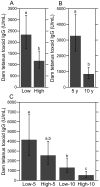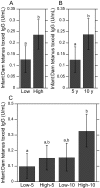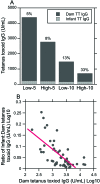Effect of Chronic Social Stress on Prenatal Transfer of Antitetanus Immunity in Captive Breeding Rhesus Macaques (Macaca mulatta)
- PMID: 29764539
- PMCID: PMC6059219
- DOI: 10.30802/AALAS-JAALAS-17-000102
Effect of Chronic Social Stress on Prenatal Transfer of Antitetanus Immunity in Captive Breeding Rhesus Macaques (Macaca mulatta)
Abstract
Because tetanus can cause significant morbidity and mortality in NHP, colonywide vaccination with tetanus toxoid is recommended for outdoor breeding colonies of rhesus macaques, with primary immunizations commonly given to infants at 6 mo of age followed by booster vaccines every 10 y. Maternal antibodies are thought to offer protective immunity to infants younger than 6 mo. However, historical colony data from the Yerkes National Primate Research Center show a higher incidence of tetanus among infants (≤ 6 mo old) born to subordinate dams. Whether this higher incidence of infantile tetanus is due to a higher incidence of trauma among subordinate animals or is a stress-induced impairment of maternal antibody protection is unknown. Studies in other NHP species suggest that chronic exposure to social stressors interferes with the receptor-mediated transplacental transfer of IgG. Therefore, the primary aim of this study was to determine whether chronic stress associated with social subordination impairs prenatal transfer of antitetanus immunity in breeding female rhesus macaques. Subjects included 26 high- and 26 low-ranking adult female rhesus macaques that were nearly 5 or 10 y after their initial immunization and their nonimmunized infants. We hypothesized that infants born to subordinate dams that were nearly 10 y after immunization would have the lowest infant-to-dam antibody ratios and thus would be at greatest risk for infection. Results revealed no significant intergroup differences in infant antitetanus IgG levels. However, infant-to-dam IgG ratios against tetanus were significantly lower among subordinate animals compared with dominant macaques, after accounting for the number of years since the dam's initial vaccination. In addition, higher maternal hair cortisol levels predicted lower infantto-dam tetanus toxoid IgG ratios. Together, these findings suggest that chronic social stress in female rhesus macaques may hamper the prenatal transfer of antitetanus immunity to offspring.
Figures






Similar articles
-
Maternal antibodies against tetanus toxoid do not inhibit potency of antibody responses to autologous antigen in newborn rhesus monkeys.J Med Primatol. 2018 Feb;47(1):35-39. doi: 10.1111/jmp.12281. Epub 2017 Jun 6. J Med Primatol. 2018. PMID: 28585307 Free PMC article.
-
Tetanus antibody titers and duration of immunity to clinical tetanus infections in free-ranging rhesus monkeys (Macaca mulatta).Am J Primatol. 2006 Jul;68(7):725-31. doi: 10.1002/ajp.20262. Am J Primatol. 2006. PMID: 16786523
-
Placental transfer of tetanus toxoid antibodies in Nigerian mothers.Ann Trop Paediatr. 1994;14(3):179-82. doi: 10.1080/02724936.1994.11747714. Ann Trop Paediatr. 1994. PMID: 7825989 Clinical Trial.
-
Maternal immunization with Haemophilus influenzae type b polysaccharide-tetanus protein conjugate vaccine in The Gambia.JAMA. 1996 Apr 17;275(15):1182-8. JAMA. 1996. PMID: 8609686 Clinical Trial.
-
Maternal immunization.Birth Defects Res. 2017 Mar 15;109(5):379-386. doi: 10.1002/bdra.23547. Birth Defects Res. 2017. PMID: 28398678 Review.
Cited by
-
Utility of Automated Feeding Data to Detect Social Instability in a Captive Breeding Colony of Rhesus Macaques (Macaca mulatta): A Case Study of Intrafamily Aggression.J Am Assoc Lab Anim Sci. 2020 Jan 1;59(1):46-57. doi: 10.30802/AALAS-JAALAS-18-000139. Epub 2019 Nov 18. J Am Assoc Lab Anim Sci. 2020. PMID: 31739825 Free PMC article.
-
Neonatal Immune System Ontogeny: The Role of Maternal Microbiota and Associated Factors. How Might the Non-Human Primate Model Enlighten the Path?Vaccines (Basel). 2021 Jun 1;9(6):584. doi: 10.3390/vaccines9060584. Vaccines (Basel). 2021. PMID: 34206053 Free PMC article. Review.
-
Effects of Transportation and Relocation on Immunologic Measures in Cynomolgus Macaques (Macaca fascicularis).J Am Assoc Lab Anim Sci. 2019 Nov 1;58(6):774-782. doi: 10.30802/AALAS-JAALAS-19-000007. Epub 2019 Oct 11. J Am Assoc Lab Anim Sci. 2019. PMID: 31604484 Free PMC article.
-
Appeasing Pheromones for the Management of Stress and Aggression during Conservation of Wild Canids: Could the Solution Be Right under Our Nose?Animals (Basel). 2021 May 27;11(6):1574. doi: 10.3390/ani11061574. Animals (Basel). 2021. PMID: 34072227 Free PMC article. Review.
References
-
- Abbott DH, Keverne EB, Bercovitch FB, Shively CA, Mendoza SP, Saltzman W, Snowdon CT, Ziegler TE, Banjevic M, Garland T, Jr, Sapolsky RM. 2003. Are subordinates always stressed? A comparative analysis of rank differences in cortisol levels among primates. Horm Behav 43:67–82. 10.1016/S0018-506X(02)00037-5. - DOI - PubMed
-
- Animal Welfare Regulations. 2013. 9 CFR §1.1–§4.11.
Publication types
MeSH terms
Substances
Grants and funding
LinkOut - more resources
Full Text Sources
Other Literature Sources

